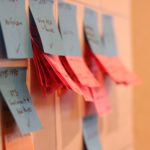How to optimize teamwork with a kanban board
Agile project management methodologies use visual tools to replace unnecessary meetings and help eliminate bottlenecks by streamlining tasks.

Everyone in BBVA’s centralized departments willl actively use agile methodologies in their day-to-day activities, equating to a total of 33.000 BBVA agile practitioners by the end of 2018. Currently, over 16,000 employees are already working with this methodology. And this figure increases on a weekly basis. Following the precepts of these business management models, multidisciplinary teams – who are encouraged to organize themselves and are empowered to execute on their ideas – have become the cornerstones of the bank. Putting agile methodologies to work helps BBVA ensure results and customer solutions that are consistently delivered in shorter time frames.
One of tools most used in agile organizations is the kanban board. Kanban is a term that comes from the combination of the Japanese words kan (visible) and ban (board or card). Building on this translation, we could say that a kanban board is a visual tool for managing projects and processes. How exactly is it used?
Broadly speaking, kanban boards should provide a graphical view of the project or process workflow, with the purpose of providing at-a-glance information about its status, progress, possible roadblocks, and issues requiring urgent attention. Traditionally, this has been done by hanging chalkboards or cork boards on office walls, an approach many professionals still prefer. Nevertheless, there are now applications that digitize these boards, an alternative that is useful when teams work remotely or are physically spread across different locations.

Kanban boards should provide a graphical view of the project or process workflow
Building the kanban board
A Kanban board should have at least three columns that deal with the progress of each task. The project or process tasks a are written down on cards or post-it notes, which are distributed across the columns. The three sections made up by the columns map to: tasks to do, tasks that are in progress, and tasks that are completed. The typical column headings are: “'To do'” (or “Planned”), “In progress,” and “Done.” In certain cases, it is also useful to include a 'backlog' column, which helps with the visualization and “parking” of pending tasks, tasks that don't need to be immediately handled.
Once the kanban board is set up, the following benefits can be expected as the project progresses:
- Rapid detection of bottlenecks and workflow weaknesses.
- Prioritization of tasks in progress.
- Elimination of unnecessary meetings that only served to update the team about basic project information
- Displaying each team member’s activities, making them more transparent for the rest of the team.
- Providing Work in Progress calculations, which contributes to a more balanced workload.
For this approach to work effectively, the following actions should complement the creation of the kanban board.
1. Correctly identify each project or process phase and its associated tasks
It is essential to create a visual and intuitive model of the workflow and how its tasks are to be executed. In other words, to clearly identify how we want to map each phase of the project to the columns we've defined. This is the only way to provide an instant view of the work in progress and possible obstacles, with the objective of helping the team be able to take corrective action.
2. Limit the work in progress
To avoid potential “points of failure” where team members are tackling a number of tasks simultaneously with the risk that one might fall through the cracks, work in progress should be kept to a minimum. Each member of the team should focus on a limited number of tasks and should not begin new ones until previous ones have been completed.
3. Short term planning to schedule tasks
Related to the previous point, planning work in short periods of time means there will be fewer tasks assigned. This is important to allow us to focus on just a few elements, ensuring they are addressed with the required quality and in the agreed timeframe.
Tasks that have been on the kanban board for a long time may not be priority, and it may be better to park them until they can be tackled when it is practical to do so.
4. Continuously Improve
A kanban board can always be improved, so it is essential to listen to everyone on the team and make changes that help tasks flow more easily from one column to another.